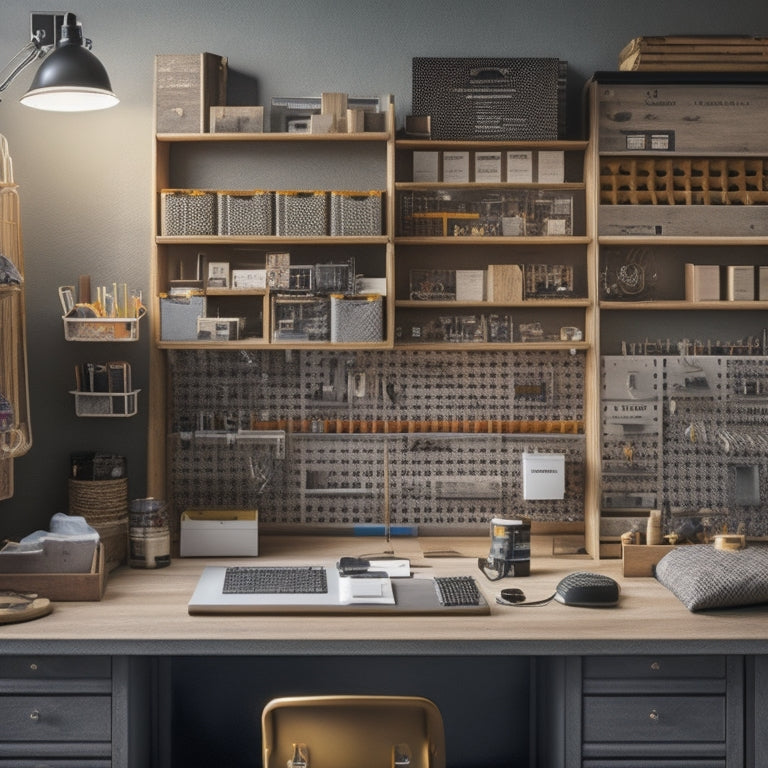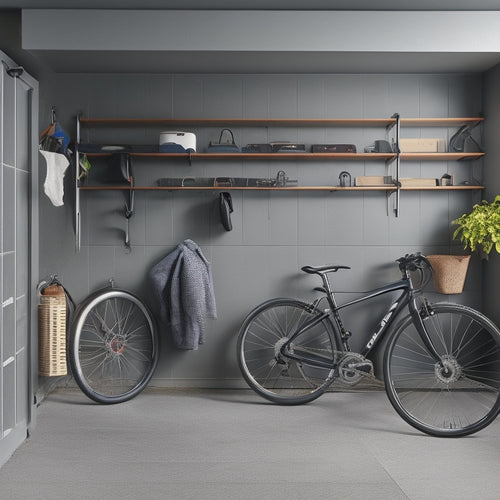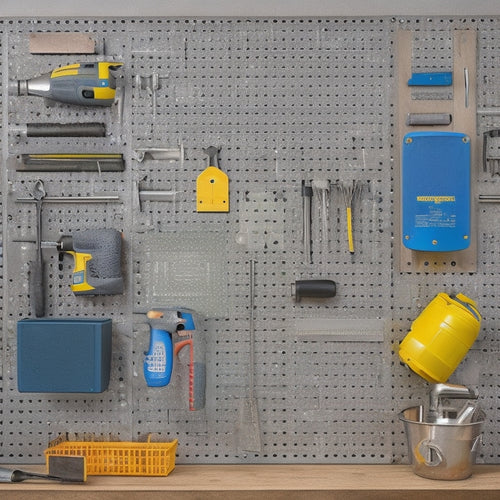
Socket Organization Ideas for Maximum Efficiency
Share
You've invested in an extensive socket set, but now it's time to maximize your efficiency by implementing a well-structured organization system. Consider socket organizers, racks, and magnetic holders to store sockets logically. Label and categorize them by size, type, and frequency of use, and group them by application or drive type. In your toolbox, allocate separate compartments for sockets, extensions, and adapters, and prioritize durable materials. On your workbench, arrange sockets in size order and separate storage for extensions and accessories. By optimizing your socket organization, you'll enhance efficiency, promote safe usage, and prolong socket lifespan - and that's just the starting point for streamlining your workflow.
Key Takeaways
- Implement a categorization system, grouping sockets by application, drive type, or size, to facilitate quick identification and access.
- Utilize socket storage solutions like trays, racks, and magnetic holders to maximize storage capacity and reduce clutter.
- Label and color-code sockets to differentiate between similar ones, and prioritize frequently used sockets for easy reach.
- Organize sockets in a logical and visually appealing manner on the workbench, considering size, type, and brand for efficient selection.
- Consider a customizable socket case with removable trays and a durable design to ensure flexibility and socket longevity.
Socket Storage Options
When it comes to socket storage options, a socket organizer tray is a versatile solution that can be mounted on a pegboard, hung on a wall, or placed on a workbench. This allows you to customize your storage setup according to your specific needs and workspace constraints.
You can also consider socket racks, which provide a compact and organized way to store your sockets. Magnetic holders are another option, allowing you to store sockets on a metal surface, such as a toolbox or a workbench.
For maximum flexibility, portable organizers or socket bags can be used to store and transport your sockets. If you prefer a more permanent solution, wall-mounted storage or pegboard systems can be installed. These provide a dedicated space for your sockets and can be easily accessed.
Additionally, drawer inserts or foam inserts can be used to organize your sockets within a toolbox or storage cabinet. By choosing the right storage option, you can guarantee that your sockets are safely stored and easily accessible, reducing the risk of damage or loss.
Labeling and Categorization Systems
How do you guarantee that you can quickly identify and retrieve the specific socket you need from your organized storage system? A well-designed labeling and categorization system is key to maximizing efficiency.
Implement labeling techniques that differentiate sockets by size, type, and usage frequency. Color coding can help visually distinguish between similar sockets, while magnetic labels or stickers can be used to identify specific sockets on a pegboard or in a drawer.
Categorization methods can group sockets by application, such as automotive or industrial, or by drive type, like ratchet or impact.
Utilize visual aids like drawer dividers or compartmentalized storage to separate and organize sockets. Tagging systems can also be used to attach labels or notes directly to individual sockets.
Consider maintaining a digital inventory to track socket usage and location. By implementing these methods, you'll be able to quickly locate the socket you need, reducing downtime and increasing productivity.
Toolbox Socket Organization
You'll want to maximize your toolbox's storage capacity by incorporating socket compartments, which can be customized to accommodate specific socket sizes and types.
Socket trays, on the other hand, provide a more flexible solution, allowing you to reorganize and reconfigure your socket layout as needed.
Socket Compartments
Socket compartments are a revolutionary element in toolbox socket organization, allowing you to categorize and store your sockets in a logical, easily accessible manner. By dividing your sockets into separate compartments based on socket size, drive, and type, you can quickly find the right socket for the job.
This organization system also enables you to store socket accessories, such as extensions and adapters, alongside their corresponding sockets.
When creating your socket compartments, consider the socket's features, usage, and applications. For instance, you may want to separate sockets by their drive type, such as 1/4", 3/8", or 1/2", or by their intended use, like spark plug sockets or impact sockets.
Additionally, consider the compatibility of sockets across different brands and models, ensuring that you can easily switch between them. Regular socket maintenance, such as cleaning and lubricating, is also made easier with a well-organized compartment system.
Socket Trays
Within the domain of toolbox socket organization, socket trays emerge as an essential component, providing a visual representation of your socket collection and allowing for swift identification and retrieval. By incorporating socket trays into your toolbox, you'll experience improved socket accessibility solutions, ensuring that the right socket is always within reach.
This, in turn, enhances socket retrieval efficiency, saving you significant time and reducing the risk of accidents caused by misplacing or fumbling with sockets.
Socket trays typically feature individual compartments or slots, each designed to hold a specific socket size or type. This organized layout enables you to quickly scan the tray and locate the required socket, eliminating the need to rummage through a disorganized toolbox.
Furthermore, socket trays often include labels or markings, allowing you to easily identify the contents of each compartment. By implementing socket trays as part of your toolbox organization strategy, you'll achieve a more streamlined and efficient workflow, reducing downtime and increasing productivity.
Socket Sets and Cases
You'll find that socket sets and cases offer a range of storage options, from compact carrying cases to large chests with individual compartments.
The materials used in these cases, such as hard plastic, metal, or soft fabric, can impact their durability and portability.
When choosing a socket set and case, consider a customizable layout that lets you arrange your sockets in a way that suits your specific needs.
Socket Storage Options
As your collection of sockets grows, so does the need for a systematic approach to storing and organizing them. You'll want to evaluate socket storage options that cater to your specific needs, taking into account the various socket types and sizes you work with.
Socket sets and cases offer an efficient way to store and transport your sockets. Look for cases with individual compartments or dividers to separate sockets by size, type, or drive style. This prevents mixing up similar-looking sockets, reducing the risk of using the wrong one for a job.
Assess cases with removable trays or inserts to customize the layout according to your socket collection. Some socket cases also feature a carrying handle or shoulder strap, making them easy to take to the job site.
When choosing a socket storage option, prioritize durability, rust-resistance, and a design that protects your sockets from damage. By investing in a well-organized socket storage system, you'll save time, reduce frustration, and guarantee your sockets remain in good condition.
Socket Case Materials
Three primary materials are used to construct socket cases: metal, plastic, and hybrid combinations of both. Metal socket organizers provide exceptional durability and are often used in heavy-duty applications. They can withstand harsh environments and are resistant to corrosion.
Plastic socket cases, on the other hand, are lightweight and more affordable. They're ideal for general-purpose use and can be easily molded into complex shapes.
Hybrid cases combine the strength of metal with the versatility of plastic. They often feature a metal frame with plastic inserts or a plastic body with metal reinforcements.
You'll also find socket cases with foam socket inserts, which provide cushioning and prevent sockets from moving around. Magnetic socket holders and portable socket bags offer added convenience, allowing you to store and transport your sockets with ease.
Stackable socket containers and weatherproof socket storage solutions guarantee your sockets remain organized and protected from the elements. Transparent socket boxes provide visibility, making it easy to identify the socket you need.
Customizable Socket Layout
With your socket case material selected, it's time to focus on creating a customizable socket layout that suits your specific needs. This involves strategically organizing your sockets to improve accessibility and efficiency. A well-structured layout will help you quickly identify the socket you need, reducing the risk of mistakes and injuries.
To achieve this, consider the following socket selection strategies and socket accessibility improvements:
| Socket Type | Frequency of Use | Layout Priority |
|---|---|---|
| SAE sockets | High | Top row, easy access |
| Metric sockets | Medium | Middle row, organized by size |
| Specialty sockets | Low | Bottom row, labeled for identification |
| Ratchets and extensions | High | Front and center, easy to grab |
| Less common sockets | Low | Back row, organized by type |
DIY Socket Holder Ideas
You're likely no stranger to the frustration of rummaging through a cluttered toolbox or drawer in search of the right socket. To combat this, you can create your own DIY socket holder ideas that cater to your specific needs. A magnetic socket holder is a great way to keep frequently used sockets within easy reach.
For more extensive collections, consider vertical socket storage or a wall-mounted socket rack to maximize storage capacity while keeping your workspace organized. If you're always on-the-go, a portable socket organizer is a must-have. This allows you to transport your sockets efficiently and access them quickly.
For those with limited drawer space, drawer socket dividers can help keep your sockets separated and organized. You can also investigate socket shelf solutions or socket grid systems for a more customized approach. If you have a large collection of sockets, a multi-tier socket organizer can help you make the most of your storage space.
Workbench Socket Layout Tips
By organizing your sockets in a logical and functional manner on your workbench, you'll be able to quickly identify and access the ones you need, reducing downtime and increasing efficiency.
Group your sockets by size, type, and brand to simplify the selection process. For instance, dedicate one section to metric sockets and another to SAE sockets. Within each section, arrange sockets in order of size, from smallest to largest. This layout allows you to quickly identify the correct socket for the task at hand, reducing the risk of using the wrong socket and damaging the material or tool.
Consider the socket materials and compatibility when organizing your layout. Place sockets made of durable materials, such as chrome-vanadium, in a prominent position for frequent usage.
Store socket extensions, accessories, and less frequently used sockets in a separate area to avoid clutter. Regularly maintain your sockets by cleaning and lubricating them to guarantee ideal performance.
A well-organized workbench socket layout not only enhances efficiency but also promotes safe usage and prolongs the lifespan of your sockets.
Frequently Asked Questions
Can I Use a Pegboard for Socket Organization?
You can definitely use a pegboard for socket organization, and it's a great idea! Pegboards offer numerous benefits, including easy accessibility and customization. Try creating creative layouts to maximize storage and minimize clutter, ensuring a safe and efficient workspace.
How Do I Organize Sockets by Drive Type?
You're about to shift gears in socket organization! Sort sockets by drive type, grouping identical drive sizes together, and further categorize by socket size to guarantee easy access and prevent mix-ups, assuring your workspace is a well-oiled machine.
Are Socket Organizers Compatible With All Toolboxes?
You'll find that not all socket organizers are compatible with every toolbox, so you'll need to check the organizer's dimensions against your toolbox's to guarantee a safe, secure fit, avoiding potential hazards and damage.
Can I Customize Socket Sets for Specific Projects?
While generic socket sets may suffice, you can't deny the appeal of tailor-made solutions; yes, you can customize socket sets for specific projects, ensuring project-specific organization and streamlined workflows that prioritize your safety and efficiency.
Do Socket Organizers Reduce Socket Loss and Misplacement?
You'll find that socket organizers greatly reduce socket loss and misplacement, streamlining your workflow through effective socket management, which is an essential benefit of organization, allowing you to focus on the task at hand while ensuring a safer work environment.
Conclusion
As you implement these socket organization ideas, you'll be amazed at the time and frustration you'll save. Did you know that a study by the National Institute of Standards and Technology found that workers spend an average of 5.6 hours per week searching for misplaced tools? By keeping your sockets organized, you'll be able to quickly find the one you need, getting you back to work faster. With a well-organized socket collection, you'll be more efficient, productive, and profitable.
Related Posts
-

Large Wall Hooks to Maximize Garage Space
You can effectively double your garage's storage capacity by installing large wall hooks that keep items off the floo...
-

Top 5 Small Tool Organizers for Your Workshop
You're looking to optimize your workshop's efficiency with high-quality small tool organizers. Compact storage soluti...
-

How to Hang a Pegboard in 5 Easy Steps
You'll hang a pegboard in 5 easy steps by first preparing the wall, ensuring it's sturdy and free of obstructions. Ne...


